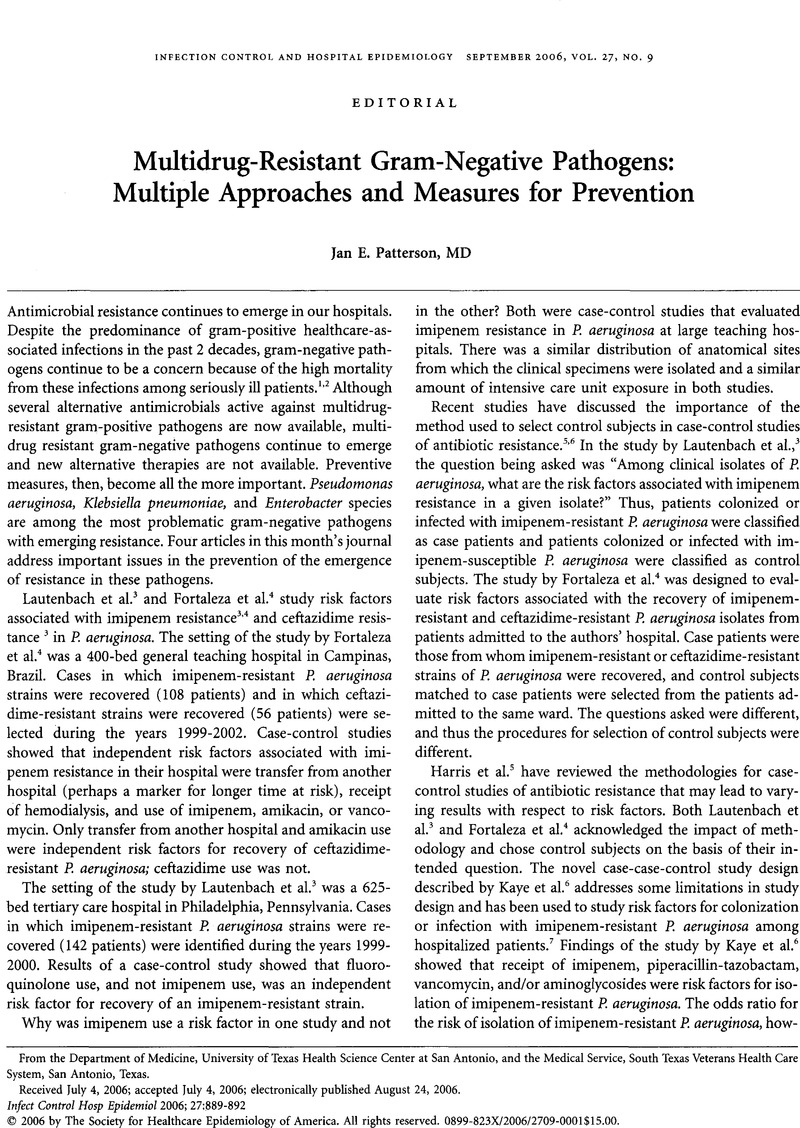Crossref Citations
This article has been cited by the following publications. This list is generated based on data provided by Crossref.
Valenti, August J.
2007.
Antimicrobial Resistance: Problem Pathogens and Clinical Countermeasures.
p.
397.
Moellering, Robert C.
Graybill, John R.
McGowan, John E.
and
Corey, Lawrence
2007.
Antimicrobial Resistance Prevention Initiative—An Update: Proceedings of an Expert Panel on Resistance.
The American Journal of Medicine,
Vol. 120,
Issue. 7,
p.
S4.
Moellering, Robert C.
Graybill, John R.
McGowan, John E.
and
Corey, Lawrence
2007.
Antimicrobial resistance prevention initiative—an update: Proceedings of an expert panel on resistance.
American Journal of Infection Control,
Vol. 35,
Issue. 9,
p.
S1.
Lautenbach, Ebbing
and
Polk, Ron E.
2007.
Resistant gram-negative bacilli: A neglected healthcare crisis?.
American Journal of Health-System Pharmacy,
Vol. 64,
Issue. 23_Supplement_14,
p.
S3.
Goldstein, Ellie J. C.
Citron, Diane M.
Peraino, Victoria
Elgourt, Tanya
Meibohm, Anne R.
and
Lu, Shuang
2009.
Introduction of Ertapenem into a Hospital Formulary: Effect on Antimicrobial Usage and Improved In Vitro Susceptibility of
Pseudomonas aeruginosa
.
Antimicrobial Agents and Chemotherapy,
Vol. 53,
Issue. 12,
p.
5122.
Curcio, D.
2010.
Yearbook of Intensive Care and Emergency Medicine 2010.
Vol. 2010,
Issue. ,
p.
257.
Curcio, D.
2010.
Intensive Care Medicine.
p.
257.
Forrest, Graeme N.
2011.
Principles and Practice of Cancer Infectious Diseases.
p.
499.
COLEMAN, B. L.
SALVADORI, M. I.
McGEER, A. J.
SIBLEY, K. A.
NEUMANN, N. F.
BONDY, S. J.
GUTMANIS, I. A.
McEWEN, S. A.
LAVOIE, M.
STRONG, D.
JOHNSON, I.
JAMIESON, F. B.
and
LOUIE, M.
2012.
The role of drinking water in the transmission of antimicrobial-resistantE. coli.
Epidemiology and Infection,
Vol. 140,
Issue. 4,
p.
633.
Shime, N.
Kosaka, T.
and
Fujita, N.
2013.
De-escalation of antimicrobial therapy for bacteraemia due to difficult-to-treat Gram-negative bacilli.
Infection,
Vol. 41,
Issue. 1,
p.
203.
Ohmagari, Norio
Kurai, Hanako
Yamagishi, Yuka
and
Mikamo, Hiroshige
2014.
Are strict isolation policies based on susceptibility testing actually effective in the prevention of the nosocomial spread of multi–drug-resistant gram-negative rods?.
American Journal of Infection Control,
Vol. 42,
Issue. 7,
p.
739.
Lovey, Arianne
Krel, Mila
Borchardt, Allen
Brady, Thomas
Cole, Jason N.
Do, Quyen-Quyen
Fortier, Joanne
Hough, Grayson
Jiang, Wanlong
Noncovich, Alain
Tari, Les
Zhao, Qiping
Balkovec, James M.
Zhao, Yanan
and
Perlin, David S.
2021.
Development of Novel Immunoprophylactic Agents against Multidrug-Resistant Gram-Negative Bacterial Infections.
Antimicrobial Agents and Chemotherapy,
Vol. 65,
Issue. 11,


